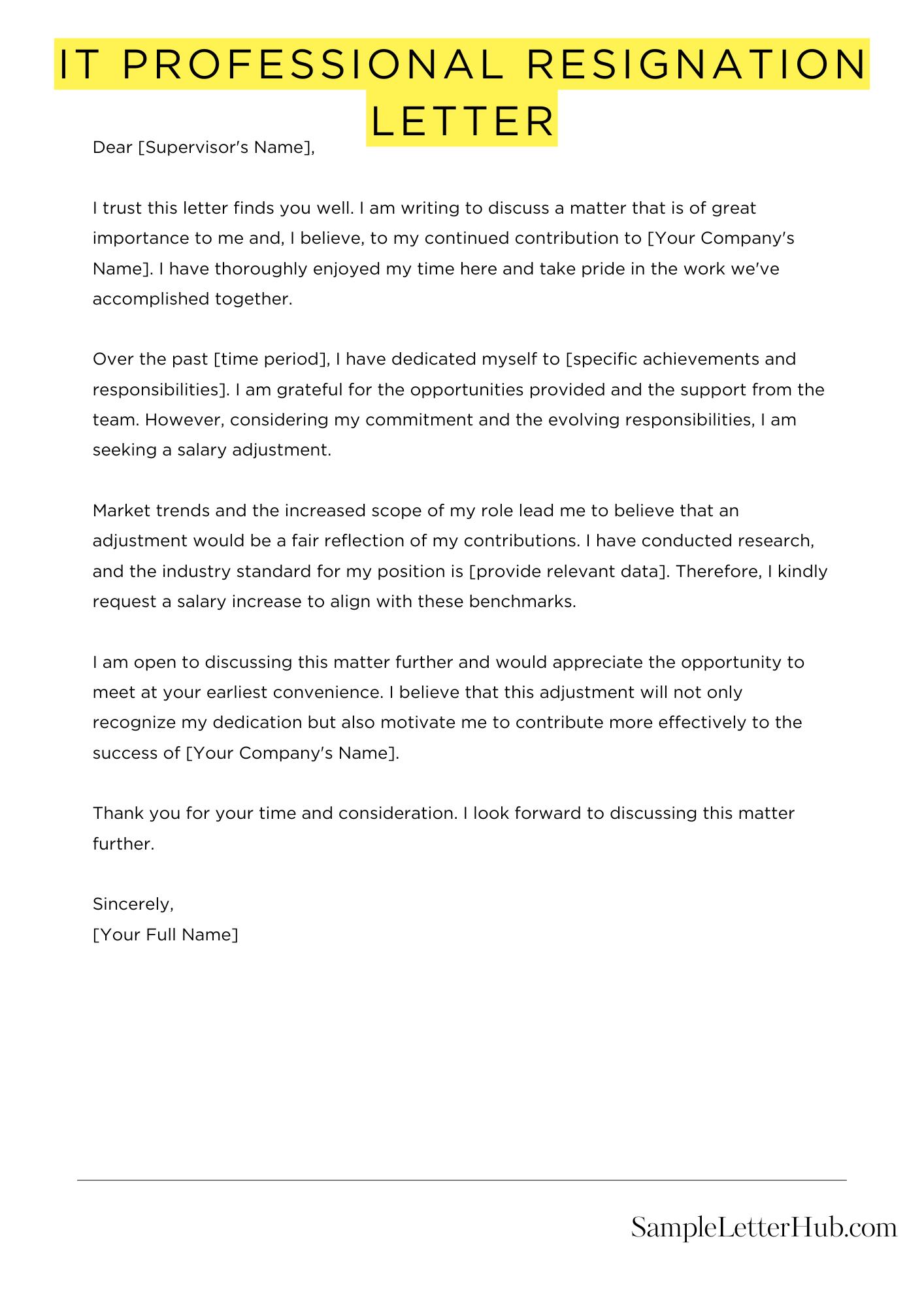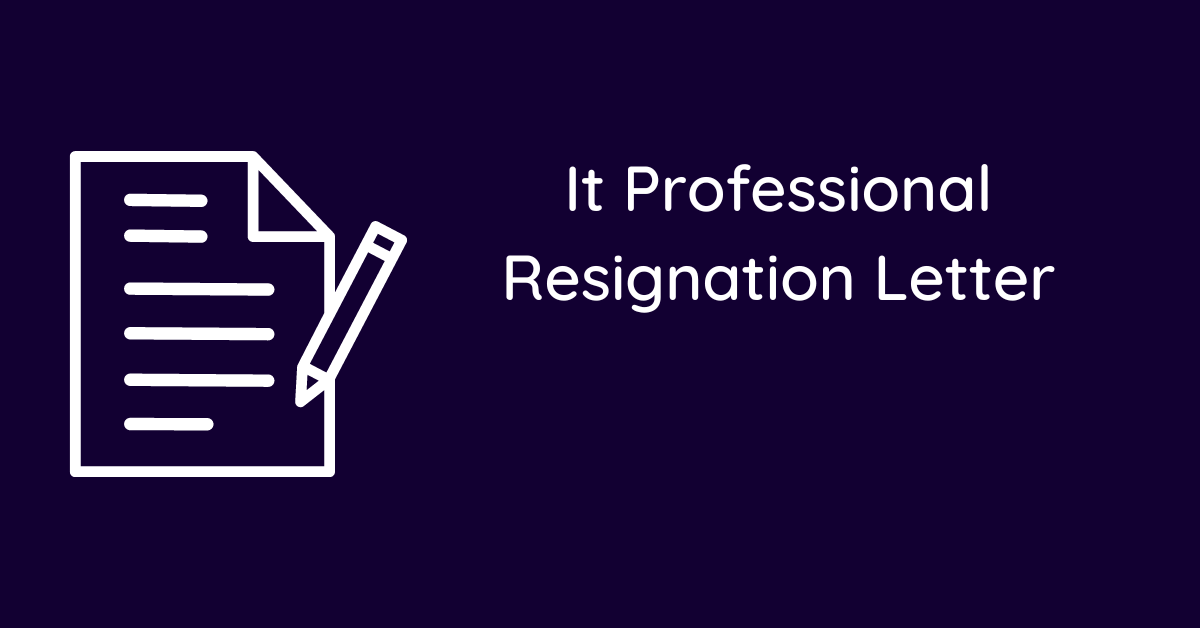When you decide to bid farewell to your current role as an IT professional, crafting a resignation letter is a crucial step. In this article, we’ll guide you through the process of writing a clear and professional resignation letter that will leave a positive impression on your employer.
Remember, a well-written resignation letter is not just a formality; it’s an opportunity to express your gratitude for the opportunities you’ve been given and to maintain a positive relationship with your former employer. Be polite and humble in your tone, and avoid any negativity or criticism.
Below, you’ll find a sample IT professional resignation letter that you can use as a template. Feel free to adapt it to fit your specific circumstances and add any additional details that you feel are relevant.
It Professional Resignation Letter
Dear [Recipient Name],
Please accept this letter as formal notification that I will be resigning from my position as IT Professional at [Company Name], effective [Last Date of Employment].
During my tenure, I have valued the opportunity to contribute to the organization’s success. I have enjoyed working alongside a talented team and appreciate the support and guidance I have received.
I wish you and [Company Name] all the best in the future.
Sincerely,
[Your Signature]
Short It Professional Resignation Letter Sample
Please accept this letter as formal notification that I am resigning from my position as It Professional at [Company Name]. My last day of employment will be [Your Last Day]. Thank you for the opportunity to grow and learn during my time here. I wish you and the company continued success. I am happy to assist in the transition process to ensure a smooth handover of my responsibilities.
I wish you all the best with your it professional resignation letter.
When it’s time to say farewell, expressing your gratitude and best wishes can make the transition smoother:

How to Write a Professional Resignation Letter
1. Start with a Formal Salutation
Begin your letter with a formal salutation, such as “Dear Mr./Ms. [Manager’s Name]”. If you’re unsure of the manager’s name, you can address the letter to “To Whom It May Concern”.
2. State Your Intention to Resign
Clearly state your intention to resign from your position. Use a phrase like, “I am writing to inform you of my decision to resign from my position as [Your Position] at [Company Name], effective [Your Last Date of Employment].”
3. Express Gratitude and Appreciation
Take this opportunity to express your gratitude for the opportunities and experiences you’ve gained during your time at the company. You can say something like, “I want to thank you for the incredible opportunities and support I’ve received during my time here. I’ve grown both professionally and personally, and I’m grateful for the experiences I’ve had.”
4. Offer to Help with the Transition
Let your manager know that you’re willing to help make the transition as smooth as possible. Offer to train your replacement or assist with any other tasks that may need to be completed before your departure.
5. End with a Professional Closing
End your letter with a professional closing, such as “Sincerely” or “Best regards”. You can also include your signature and typed name below the closing.
6 Most Frequently Asked Questions About IT Professional Resignation Letters
Resigning from your IT professional position can be a daunting task. To help you navigate the complexities of this process, we’ve compiled a list of the most frequently asked questions and their answers.
1. What is the proper format for an IT professional resignation letter?
Your resignation letter should be formal and concise. It should include your name, address, date, company name, and manager’s name. State your intention to resign, your last date of employment, and express your gratitude for the opportunity to work at the company.
2. How much notice should I give?
The standard notice period for IT professionals is two weeks. However, it’s always advisable to give as much notice as possible to allow your employer ample time to find a replacement.
3. What should I include in my resignation letter?
In addition to the basic information mentioned above, you may also want to include a brief statement about your reasons for leaving. Keep it professional and avoid being negative or critical of the company.
4. Do I need to submit a resignation letter if I’m leaving on good terms?
Yes. Even if you’re leaving on good terms, it’s important to submit a formal resignation letter. This will help to maintain a professional relationship with your employer and ensure a smooth transition during your departure.
5. What if I’m not sure about my last date of employment?
If you’re not sure about your last date of employment, it’s best to consult with your manager. They will be able to provide you with the necessary information.
6. Can I negotiate my notice period?
In some cases, you may be able to negotiate your notice period with your employer. However, this is not always possible, so it’s important to be prepared to give the standard two weeks’ notice.
Before making the decision to resign from your job, it’s essential to consider the legal aspects:
Understanding your emotions after quitting your job is important. Explore why you might be feeling sad:
Related
- Resignation letter sample
- Forced resignation letter
- Resignation letter due to going abroad
- Resignation letter due to marriage
- Resignation letter due to other opportunity
- Resignation letter due to mistake

